The SMIL specification was introduced by the W3C in 1998 for synchronizing multimedia. This was lengthy sooner than CSS animations or JavaScript-basically basically based animation libraries had been on hand. It was built into SVG 1.1, which is why we can calm use it there this day.
Now, it is possible you’ll maybe’ve heard that SMIL is ineffective. On the choice hand, it’s alive and smartly since Google reversed a method to deprecate the technology nearly a decade within the past. It remains an ideal alternative for designers and developers who favor straightforward, semantic techniques to add animations to their designs.
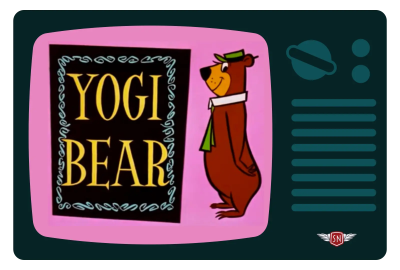
Tip: There’s now a web page the safe aside it is possible you’ll eye all my Toon Titles.
Introducing Mike Worth
I’ve lately been engaged on a new web web page for Emmy-award-winning sport composer Mike Worth. He employed me to provide a mettlesome, retro-style produce that showcases his work. I identical old animations throughout to pleasure and surprise his viewers as they transfer by map of his web web page.
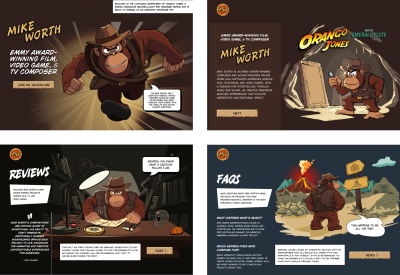
Mike loves ’90s animation — namely Disney’s Duck Tales. Unsurprisingly, my style in cartoons stretches encourage a minute bit extra to Hanna-Barbera reveals bask in Dastardly and Muttley in Their Flying Machines, Scooby-Doo, The Perils of Penelope Pitstop, Wacky Races, and, of route, The Yogi Undergo Demonstrate. So, to reveal how this era of animation pertains to SVG, I’ll be including SMIL animations in SVG to title cards from some traditional Yogi Undergo cartoons.
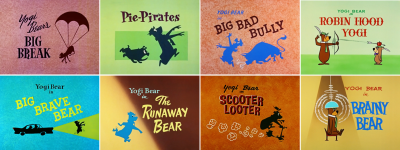
Fundamentally, animation adjustments how an component looks and the safe aside it looks over time the use of a few general tactics. That is susceptible to be simply intelligent an component up or down, left or lovely, to provide the look of motion, bask in Yogi Undergo transferring across the camouflage.
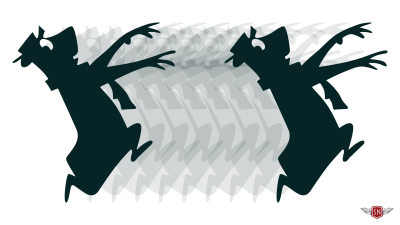
Rotating objects around a mounted level can produce all the things, from straightforward spinning results to natural-having a worth movements of entirely frequent things, bask in a endure below a parachute falling from the sky.
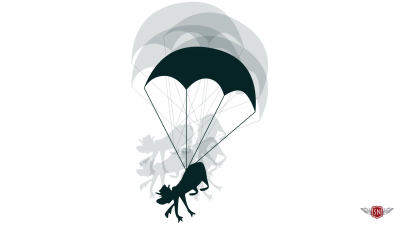
Scaling makes an component develop, shrink, or stretch, which would possibly perhaps maybe add drama, produce perspective, or simulate depth.

Changing colour and transitioning opacity can add ambiance, produce a mood, and make stronger visible storytelling. Correct these general principles can produce animations that attract attention and toughen any individual’s trip the use of a produce.
These results are all achievable the use of CSS animations, however some SVG properties can’t be bright the use of CSS. Fortunately, we can attain extra — and own grand extra fun — the use of SMIL animations in SVG. We are succesful of combine advanced animations, transfer objects alongside paths, and protect watch over when they begin, pause, and all the things in between.
Animations can even be embedded within any SVG factor, including identical old shapes bask in circles, ellipses, and rectangles. They’ll additionally be encapsulated into groups, paths, and polygons:
...
Animations can additionally be defined outside an component, in other locations in an SVG, and linked to it the use of an xlink attribute:
...
...
…
Constructing An Animation
attributeName label, it permits animations per one or extra of an component’s attributes.
Most animation explanations begin by transferring a identical old shape, bask in this thrilling circle:
The utilization of this attributeName property, I can outline which of this circle’s attributes I want to animate, which, in this situation, is its cx (x-axis heart level) space:
By itself, this does precisely nothing unless I outline three extra values. The from key phrase specifies the circle’s preliminary space, to, its final space, and the dur-ation between these two positions:
If I want extra true protect watch over, I can replace from and to with a space of values separated by semicolons:
Within the damage, I can outline how frequently the animation repeats (repeatcount) and even after what length that repeating would possibly perhaps maybe additionally calm pause (repeatdur):
Most SVG formulation own attributes that can even be bright. This title card from 1959’s “Brainy Undergo” episode reveals Yogi in a loopy scientist‘s brain experiment. Yogi’s head is below the dome, and energy radiates around him.
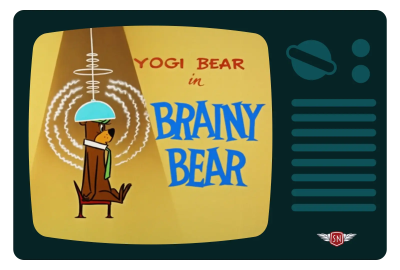
To provide the fun around Yogi, my SVG entails three path formulation, every with opacity, stroke, and stroke-width attributes, which would possibly perhaps maybe all be bright:
I bright every course’s opacity, changing its label from 1 to .5 and encourage one more time:
Then, to radiate energy from Yogi, I specified when every animation would possibly perhaps maybe additionally calm begin, the use of a clear label for every path:
I’ll disclose extra about the begin property and the technique to begin animations after this short industrial spoil.
Attach this your self:
Assume the Pen [Brainy Bear SVG animation [forked]](https://codepen.io/smashingmag/pen/qEEzYgG) by Andy Clarke.
To effect animations appear extra natural, I can practice extra than one animate factor and give every particular person a clear attributename label. Those paths additionally gain a stroke-width attribute, which I can additionally animate by changing the stroke widths between 5 and 7:
Within the damage, I can animate the dome over Yogi’s head, changing its fill colour between two values over five seconds to provide the impact that the loopy scientist’s machine is heating up:
Enforce that code, and you’ll soon eye that the dome returns to its normal dispute after the animation is full. To wait on its colour on the cease of the animation, I can add the — confusingly named — fill property and a label of freeze. This stops the animation in its final dispute and prevents it from returning to the typical colour:
Animating attributes brings these title card designs to life, whether by adjusting the space of a identical old shape, its opacity, and stroke width or by increasing advanced sequences with staggered timing. But there’s calm extra I can attain, starting with the following animation factor, animateTransform.
animateTransform
If animateTransform animates transformations, including rotations, scaling, skewing, and translations. It genuinely works by changing the values of a change into property, bask in this translate:
Then, the animation works the identical capacity as attributename and specifying the effect of change into, in this situation, rotate:
I can use both from and to or the values attribute to stipulate how an component is remodeled.
- Scale uses
xandyvalues (.5,1). - Rotate uses degrees (
0–360) plus optionally availablexandy(360,0,0). - Translate additionally uses
xandyvalues (50,100). - Skew uses
xandyvalues, too (50,100).
What’s though-provoking about these values is that they’ll also be added to an component’s existing values rather then changing them. For instance, when an attribute incorporates a translate label of 100, 0:
After which I animate that translation horizontally by 100:
The utilization of the additive property with a label of sum, the animation values are relative to the typical, starting the animation at 100 and ending at 200 by including 100 to 100.
Equally, if I give the accumulate property a label of sum, every occasion of animation will invent on the closing. So, in an animation the safe aside an component is translated by 100 and repeats five times, every motion will seemingly be cumulative, transferring the factor by 500:
This title card from 1958’s Yogi Undergo’s “Abundant Ruin” episode reveals Yogi floating from the sky below a parachute.

I wished two forms of change into animations to generate the attain of Yogi drifting gently downwards: translate, and rotate. I first added an animatetransform factor to the team, which contains Yogi and his chute. I defined his preliminary vertical space — 1200 off the high of the viewBox — then translated his descent to 1000 over a 15-second length:
...
Yogi looks to topple from the sky, however the motion looks unrealistic. So, I added a second animatetransform factor, this time with an indefinitely repeating +/- 5-level rotation to swing Yogi from aspect to aspect throughout his descent:
Attach this your self:
Assume the Pen[AbundantRuinSVGanimation[BigBreakSVGanimation[forked]](https://codepen.io/smashingmag/pen/PwwraNm) by Andy Clarke.
Starting And Stopping
To this level, every animation begins as soon as the gain page has loaded. But there are suggestions to now no longer finest delay the begin of animation however outline precisely the safe aside it begins, the use of the begin up property:
On this title card from 1959’s “Robin Hood Yogi”, Yogi shoots an arrow into an apple on Boo-Boo’s head.

By default, the arrow is space free when the gain page masses. Blink, and it is possible you’ll maybe leave out it. To invent some anticipation, I can begin the animation two seconds later:
Or, I can let the viewer rob the shot when they click the arrow:
And I can combine the clicking occasion and a delay, all with out a JavaScript, lovely a smattering of SMIL:
Attach this your self by clicking the arrow:
Assume the Pen[RobinHoodYogiCSSanimation[RobinHoodYogiCSSanimation[forked]](https://codepen.io/smashingmag/pen/OPPeERj) by Andy Clarke.
Synchronising Animations
In his 1958 “Pie-Pirates” episode, Yogi Undergo tries to hold a pie and has to outwit a bulldog. The title card — designed by Lawrence Goble — reveals the move however, alas, (spoiler alert) no stolen pie.
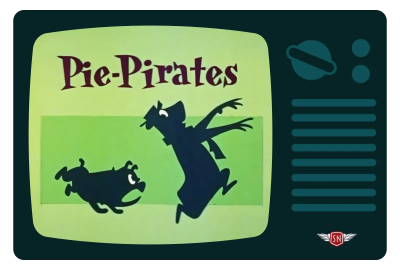
To bring this title card to life, I wished two groups of paths: one for Yogi and the choice for the canines. I translated them every off the left fringe of the viewBox:
...
...
Then, I utilized an animatetransform factor to every groups, which moves them encourage into scrutinize:
This gadgets up the motion, however the attain feels flat, so I added one more pair of animations that leap every characters:
Animations can begin up when a web page masses, after a specified time, or when clicked. And by naming them, they can additionally synchronise with other animations.
I wished Yogi to enter the frame first to invent anticipation, with a short pause sooner than other animations begin up, synchronising to the second he’s arrived. First, I added an ID to Yogi’s translate animation:
Assume out: For a motive, I can’t, for the lifetime of me, disclose why Firefox won’t begin up animations with an ID when the ID incorporates a hyphen. This isn’t smarter than the moderate browser, however changing hyphens with underscores fixes the anguish.
Then, I utilized a begin to his rotate animation, which begins playing a half of-second after the #yogi animation ends:
I can invent refined gadgets of synchronised animations the use of the begin property and whether a named animation begins or ends. The bulldog chasing Yogi enters the frame two seconds after Yogi begins his entrance:
One second after the canines has caught up with Yogi, a rotate transformation makes him leap, too:
The background rectangles whizzing previous are additionally synchronised, this time to one second sooner than the bulldog ends his walk:
Attach this your self:
Assume the Pen[Pie-PiratesSVGanimation[Pie-PiratesSVGanimation[forked]](https://codepen.io/smashingmag/pen/LEEKryp) by Andy Clarke.
The timing of this background motion is synchronised with the canines arriving, which, in turn, is relative to Yogi’s arrival, building a chain of animations that every particular person feel linked.
Animating Along Motion Paths
Till now, the full animations in these title cards were up, down, left, lovely, or one mixture or one more. But there’s one extra aspect of SMIL in SVG, which would possibly perhaps maybe add an extra dimension to animations: animating alongside motion paths the use of the animatemotion factor.
animatemotion accepts the full identical properties and values as animate and animateTransform, however adds a few extra for finer protect watch over over route and timing. animatemotion uses the path property to permit formulation to transfer alongside a motion course. It additionally uses the d label for coordinate records within the identical capacity as any dilapidated course.
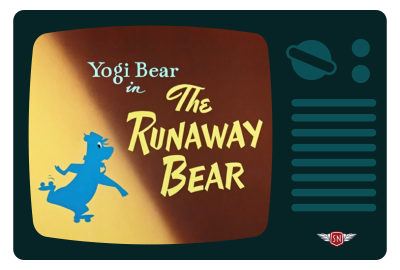
In “The Runaway Undergo” from 1959, Yogi must steer positive of a hunter turning his head staunch into a trophy. I wished Yogi to soar in and out of the camouflage by making him notice a course. I additionally wished to differ the rate of his walk: speeding up as he enters and exits, and slowing down as he passes the title text.
I first added a path property, the use of its coordinate records to give Yogi a route to notice, and specified a two-second length for my animation:
Alternatively, I would possibly perhaps maybe add a path factor, leave it visible, or pause it from being rendered by putting it inside of a defs factor:
I can then reference that by the use of a mpath factor inside of my animateMotion:
I experimented with plenty of paths sooner than settling on the actual person that delivered the motion shape I was shopping for:
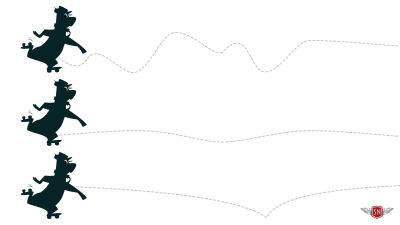
One was too bouncy, one was too flat, however the third motion course was lovely lovely. Nearly, as I additionally wished to differ the rate of Yogi’s walk: speeding him up as he enters and exits and slowing him down as he passes the title text.
The keyPoints property enabled me to specify facets alongside the motion course and then adjust the length Yogi spends between them. To protect things straightforward, I defined five facets between 0 and 1:
Then I added the identical alternative of keyTimes values, separated by semicolons, to manipulate the pacing of this animation:
Now, Yogi rushes by map of the first three keyPoints, slows down as he passes the title text, then speeds up one more time as he exits the viewBox.
Attach this your self:
Assume the Pen[RunawayUndergoSVGanimation[RunawayBearSVGanimation[forked]](https://codepen.io/smashingmag/pen/oggryox) by Andy Clarke.
With their ability to manipulate transformations, animate advanced motion paths, and synchronise extra than one animations, SMIL animations in SVG are calm valuable instruments. They’ll bring produce to life with out needing a framework or relying on JavaScript. It’s compact, which makes it mountainous for tiny SVG results.
SMIL entails the begin attribute, which makes chaining animations far extra intuitive than with CSS. Plus, SMIL lives contained within the SVG file, making it very finest for animations that accelerate with an asset. So, whereas SMIL is now no longer smartly-liked by this day’s standards and will seemingly be a minute bit bit niche, it will probably maybe calm be magical.
Google reversed its method to deprecate SMIL nearly a decade within the past, so it remains an ideal alternative for designers and developers who favor straightforward, semantic techniques to add animations to their designs.
(yk)






